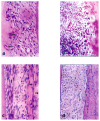The Effect of Systemic Delivery of Aminoguanidine versus Doxycycline on the Resorptive Phase of Alveolar Bone Following modified Widman Flap in Diabetic Rats: A Histopathological and Scanning Electron Microscope (SEM) study
- PMID: 25505863
- PMCID: PMC4257363
- DOI: 10.12816/0023980
The Effect of Systemic Delivery of Aminoguanidine versus Doxycycline on the Resorptive Phase of Alveolar Bone Following modified Widman Flap in Diabetic Rats: A Histopathological and Scanning Electron Microscope (SEM) study
Abstract
Objectives: Aminoguanidine (guanylhydrazinehydrochloride) is a drug that prevents many of the classical systemic complications of diabetes including diabetic osteopenia through its inhibitory activity on the accumulation of advanced glycation end -products (AGEs). The aim of the present study was to evaluate the effectiveness of aminoguanidine versus doxycycline in reducing alveolar bone resorption following mucoperiosteal flap in diabetic rats, using the conventional histopathology and scanning electron microscope (SEM).
Methods: Twenty-seven male albino rats were used in this study. Periodontal defects were induced experimentally on lower anterior teeth. All rats were subjected to induction of diabetes, by IV injection of the pancreatic B-cells toxin alloxan monohydrate. After eight weeks following the establishment of periodontal defects in all rats, the ligation was removed and 3 rats were scarified as negative control (group 1). The remaining animals were divided into three group based on treatment applied following mucoperiosteal flap surgery. Group 2 received saline treatment only, group 3 received doxycycline periostat (1.5 mg/kg/day) for 3 weeks, and group 4 received aminoguanidine (7.3 mmol/kg) for 3 weeks. The fasting glucose level was measured weekly post operatively. After 21 days all rats were sacrificed. Three anterior parts of the mandible of each group was prepared for histopathological examination and two parts were prepared for SEM.
Results: Aminoguanidine treated group (group 4) showed statistically significant increased new bone formation, higher number of osteoblasts and decrease osteoclasts number, resorptive lacunae and existing inflammatory cell infiltration as compared to positive control group (group 2) (P<0.05). Doxycycline was also effective in reducing bone loss as documental by histopathological study.
Conclusion: The present study showed that aminoguanidine was significantly effective in reducing alveolar bone loss and can modify the detrimental effects of diabetes in alveolar bone resorption.
Figures


Similar articles
-
A histopathological investigation on the effect of systemic administration of the bisphosphonate alendronate on resorptive phase following mucoperiosteal flap surgery in the rat mandible.J Periodontol. 2003 Sep;74(9):1348-54. doi: 10.1902/jop.2003.74.9.1348. J Periodontol. 2003. PMID: 14584869
-
A histopathological investigation on the effects of the bisphosphonate alendronate on resorptive phase following mucoperiosteal flap surgery in the mandible of rats.J Periodontol. 2000 May;71(5):790-6. doi: 10.1902/jop.2000.71.5.790. J Periodontol. 2000. PMID: 10872961
-
Doxycycline prevents root resorption and alveolar bone loss in rats after periodontal surgery.Scand J Dent Res. 1993 Oct;101(5):287-91. doi: 10.1111/j.1600-0722.1993.tb01122.x. Scand J Dent Res. 1993. PMID: 8248731
-
Local delivery of an amino bisphosphonate prevents the resorptive phase of alveolar bone following mucoperiosteal flap surgery in rats.J Periodontol. 1997 Sep;68(9):884-9. doi: 10.1902/jop.1997.68.9.884. J Periodontol. 1997. PMID: 9379334
-
Modulating the effects of diabetes on osseointegration with aminoguanidine and doxycycline.J Periodontol. 2005 Apr;76(4):614-20. doi: 10.1902/jop.2005.76.4.614. J Periodontol. 2005. PMID: 15857103
Cited by
-
Novel Insight into the Mechanisms of the Bidirectional Relationship between Diabetes and Periodontitis.Biomedicines. 2022 Jan 16;10(1):178. doi: 10.3390/biomedicines10010178. Biomedicines. 2022. PMID: 35052857 Free PMC article. Review.
References
-
- Offenbacher S, Salvi GE. Induction of prostaglandin release from macrophages by bacterial endotoxin. Clinical infectious diseases: an official publication of the Infectious Diseases Society of America. 1999;28(3):505–13. Epub 1999/04/08. - PubMed
-
- Seibold JR, Uitto J, Dorwart BB, Prockop DJ. Collagen synthesis and collagenase activity in dermal fibroblasts from patients with diabetes and digital sclerosis. The Journal of laboratory and clinical medicine. 1985;105(6):664–7. Epub 1985/06/01. - PubMed
-
- Vlassara H. The AGE-receptor in the pathogenesis of diabetic complications. Diabetes/metabolism research and reviews. 2001;17(6):436–43. Epub 2002/01/05. - PubMed
-
- Schmidt AM, Weidman E, Lalla E, Yan SD, Hori O, Cao R, et al. Advanced glycation endproducts (AGEs) induce oxidant stress in the gingiva: a potential mechanism underlying accelerated periodontal disease associated with diabetes. J Periodontal Res. 1996;31(7):508–15. Epub 1996/10/01. - PubMed
-
- Peppa M, Uribarri J, Vlassara H. Glucose, advanced glycation end products and diabetes complication: what is new and what works. clinical diabetes. 2003;4(21):186–7.
LinkOut - more resources
Full Text Sources
